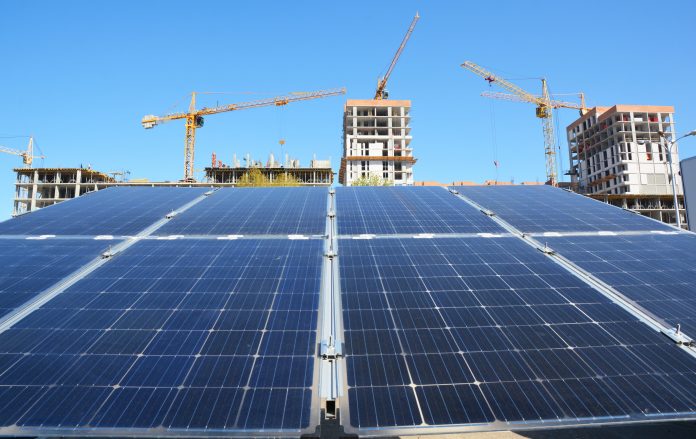It’s been a slow, but significant shift in perception, outlook and activity, but there’s no doubt the last decade has seen sustainability gradually rise up the agenda to become a priority for UK’s built environment professionals. Chris Stanley, housing manager at Modern Masonry explains more
It’s now an expectation, opposed to the exception, to incorporate a form of green directive or clause within a design brief. Building product manufacturers for their part understand their responsibility to mitigate climate change through more eco-friendly production processes.
In turn, Net Zero 2050 has provided a useful incentive and challenge across business and industry to protect our environment for future generations. It’s all positive change and is welcomed.
However, there’s still some way to go. Three decades sounds like a long time, but it’s really just around the corner. Put in context, it’s a very short margin in which to halt and reverse the damage done over 250 years of industrial activity and energy consumption.
Although Covid has had an impact on progress, according to the independent advisory body, The Climate Change Committee, most sectors are generally off-track. We need to take this seriously otherwise we risk undoing all the positive work we’ve done and fail to meet those essential targets 29 years down the line.
It will take a concerted effort, and I believe everyone across the construction sector needs to reflect and reappraise current practices. It’s an exercise myself and colleagues at Modern Masonry and our membership are familiar with. Over the last few years, we’ve invested heavily in looking at ways to make our products not only more sustainable in themselves but relevant to sustainable design requirements.
We have also explored the concept of ‘sustainability’ itself and have come to the conclusion that it’s a richer, more holistic term, as opposed to the narrowcast interpretation the term is often subjected to. Fundamentally, it should go beyond the pure manufacturing of the product itself.
So, drawing on our members’ and association’s considerable expertise, I’d like to invite you to consider sustainability in a much broader light. Using the humble block as an example, I’ll demonstrate there’s more than initially meets the eye to deliver a greener future.
Consider the composition
The last few years has seen considerable investment made into the make-up of blocks with many manufacturers working to produce the material in a circular way. For examples, all our members, which includes some of the biggest, most recognised brand names in the built environment are pledged to using aggregates that are 100% recyclable at end of use. This ensures as much embodied carbon is recaptured at end of life, and eases pressure on excavating virgin resources.
Further, intensive research is being done into alternative, cementitious compounds which can replace a proportion of the already small amounts of cement used in block production. Examples of these is PFA (Pulverised Fuel Ash) and FBA (Furnace Bottom Ash), both by-products of the steel industry.
Where once these waste materials sat redundantly on slagheaps across the UK, they are finding a new lease of life in concrete products. Used in conjunction with cement, it creates as strong a chemical bond with a significantly lower carbon footprint, and is fast becoming standard industry-wide.
Drawing out the best performance
With a growing emphasis on the ‘Fabric First’ approach towards building, and a drive toward reducing reliance on carbon-intensive mechanical HVAC systems, the thermal performance of construction material has become vitally important.
Aside from embodying eco-friendly principles, modern blocks also help passively, to deliver further sustainable benefits, particularly when used in solid or cavity wall construction.
Specified in conjunction with high-performance insulation and the right detailing, they help utilise a building’s thermal mass which can be utilised in the heating and cooling seasons. This not only delivers a more comfortable, energy-efficient solution but significantly reduces CO2 emissions and ensure lower utility bills.
Local hero
When focusing on CO2 emissions, shipping and logistics and easily be overlooked. A hyper-local product, it’s estimated any construction site is less than 40 miles away from a healthy supply of concrete blocks. This small, robust supply chain means less transportation, and as a result, a lower carbon footprint.
Further, most concrete blocks used in UK construction are manufactured domestically from locally sourced materials, this means there are no ocean freight costs associated with imported materials like structural timber.
This further reduces a block’s overall environmental footprint.
A wider, positive impact can also be registered if we consider sustainability in a social context. The block manufacturing industry also supports a large number of jobs, often in remote rural areas, supporting and strengthening community and ensuring their survival and prosperity for years to come.
Natural resurgence
Our members, as with the wider concrete industry, are acutely aware of the responsibility to give back to the environment and ensure any activity, such as quarrying, is remediated at end of life.
Towards the end of last year our affiliate organisation, The Mineral Products Association (MPA), announced that its members have already created over 8,000 hectares of UK priority habitats such as meadows, heathland, broadleaved woodland, and wetlands including lakes, ponds and reedbeds. Looking forward, a further 11,000 hectares, at least, is in the pipeline in approved restoration schemes.
Giving back is incredibly important, especially if we are to revive existing and establish new natural habitats, and I think manufacturers should do as much as they can to mitigate past excavation and extraction work. I’m very proud that our industry is leading the way, further demonstrating how working sustainably is much more than the product production itself.
Long-term future
Climate change is an unavoidable issue and the construction and building product manufacturing industry needs to act fast to mitigate and reverse its deleterious effects. However, as hopefully demonstrated above, there are many ways in which sensible material choices can have a positive effect.
However, making the right decision requires a degree of discernment, so when considering ‘sustainability’ in relation to materials, dig a little deeper as often there’s more than initially meets the eye.
Chris Stanley
Housing Manager














